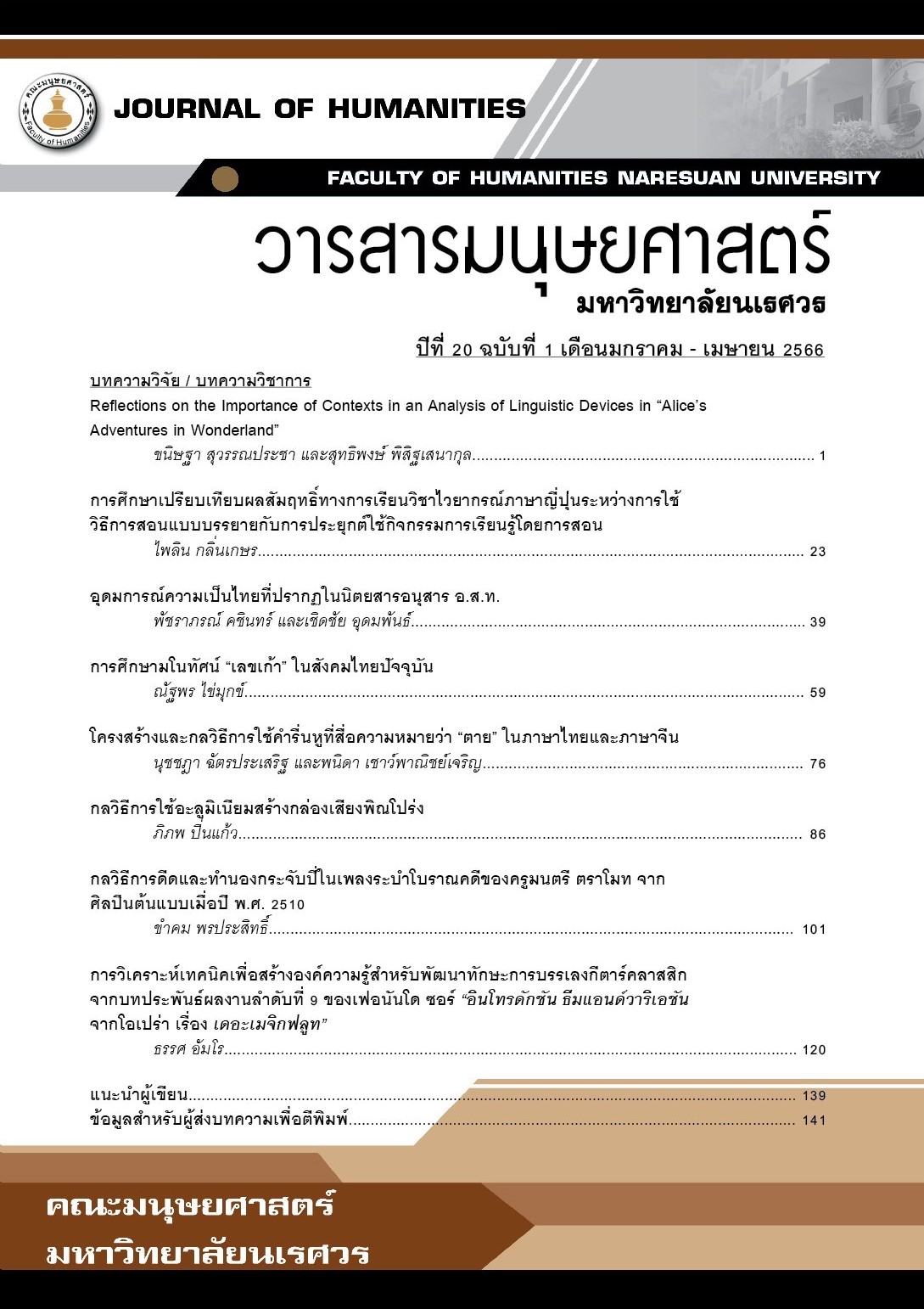ภาพสะท้อนความสำคัญของปริบทในการวิเคราะห์กลวิธีทางภาษาในเรื่อง "การผจญภัยของอลิซในแดนมหัศจรรย์"
Main Article Content
บทคัดย่อ
การศึกษานี้มีวัตถุประสงค์เพื่อวิเคราะห์และตีความการใช้กลวิธีทางภาษาใน "Alice’s Adventures in Wonderland" โดย Lewis Carroll ซึ่งสะท้อนความสำคัญของปริบท เครื่องมือที่ใช้ในการวิจัยคือตารางวิเคราะห์กลวิธี การใช้ภาษาซึ่งมุ่งศึกษาคำผิดความหมายและการเล่นคำ (คำพ้องรูปพ้องเสียง คำพ้องรูป และคำพ้องเสียง) จากนั้นวิเคราะห์ปริบทสามด้าน ได้แก่ ปริบททางภาษาและปริบททางสถานการณ์ ตามแนวคิดของทฤษฎีไวยากรณ์เชิงระบบหน้าที่ของ M.A.K. Halliday รวมถึงปริบททางวัฒนธรรมเพื่อหาคำเป้าหมาย ความหมายที่เป็นไปได้ และความหมายแฝง ผลการศึกษาแสดงกลวิธีทางภาษาที่ใช้ในเรื่อง ได้แก่ การใช้คำผิดความหมาย จำนวน 20 แห่ง การเล่นคำ 16 แห่ง จำแนกเป็นการใช้คำพ้องรูปพ้องเสียง และ คำพ้องเสียง อย่างละ 8 แห่ง บทวิเคราะห์พบว่า ปริบททางภาษาทั้งสามด้านช่วยให้การตีความกลวิธีการใช้คำผิดความหมาย และการเล่นคำมีประสิทธิภาพซึ่งส่งผลให้เกิดความเข้าใจในตัวเรื่อง ความคิด และความรู้สึกของตัวละครมากขึ้น
Article Details

อนุญาตภายใต้เงื่อนไข Creative Commons Attribution-NonCommercial-NoDerivatives 4.0 International License.
ข้อความรู้ใด ๆ ตลอดจนข้อคิดเห็นใด ๆ เป็นของผู้เขียนแต่ละท่านโดยเฉพาะ คณะมนุษยศาสตร์ มหาวิทยาลัยนเรศวร และกองบรรณาธิการวารสารมนุษยศาสตร์ฯ ไม่จำเป็นต้องเห็นพ้องด้วย
เอกสารอ้างอิง
Ambrosiani, P. (1999). A Russian tail? on the translation of puns in Lewis Carroll’s Alice’s adventure in wonderland. In A. Bengtsson & V. Hancock (Eds.), Humour in language: Textual and linguistics aspects (pp. 30-63). Stockholm: Acta Universitatis Stockholmiensis.
Auerbach, N. (1973). Alice and wonderland: A curious child. Victorian Studies, 17(1), 31-47. Retrieved on January 23, 2021, from http://www.jstor.org/stable/3826513
Brinton, L. J., & Brinton, D. M. (2010). The linguistic structure of modern English. Amsterdam: John Benjamins Publishing Company.
Bulut, T., & Almabrouk, N. (2020). The functions of puns in “Alice’s adventures in wonderland”. The Reading Matrix: An International Online Journal, 20(1), 172-185.
Cambridge University Press. (n.d.). Cambridge Dictionary. Retrieved on January 10, 2020, from https://dictionary.cambridge.org
Carroll, L. (2016). Alice’s adventures in wonderland and through the looking-glass. San Diego: Canterbury Classics.
Chiang, Y. (2013). Nonsense humor: A battlefield for Ludwig Wittgenstein or a playground for Lewis Carroll. HSIUPING Journal of Humanities and Social Sciences, 20, 27-46.
Cook, G. (1994). Discourse and literature: The interplay of form and mind. Oxford: Oxford University Press.
Debrota, C. (2019). Translation strategies in Alice in wonderland's rhymes. Translation Studies: Retrospective and Prospective Views, 12(22), 13-19.
Feng, Z. (2009). Translation and reconstruction of a wonderland: Alice’s adventures in China. Neohelicon, 36, 237–251.
Ferrari, G. (1997). Types of context and their role in multimodal communication. Computational Intelligence, 13(3), 414-426.
Finegan, E. (2008). Language: Its structure and use (5th ed.). Boston, MA: Thomson Wadsworth.
Flescher, J. (1969). The language of nonsense in Alice. Yale French Studies, 43, 128–144. Retrieved from https://doi.org/10.2307/2929641
Fray, D., & Cutler, A. (1997). Malapropisms and the structure of the mental lexicon. Linguistic Inquiry, 8(3), 505-520.
Gee, J. P. (1999). An introduction to discourse analysis: Theory and method. New York: Routledge.
Giorgadze, M. (2014). Linguistic features of pun, its typology and classification. European Scientific Journal, 2, 271-275.
Grice, H. P. (1975). Logic and conversation. In P. Cole & J. L. Morgan (Eds.), Syntax and semantics 3: Speech acts (pp.41-58). New York: Academic Press.
Halliday, M. A. K., & Matthiessen, C. (2013). Halliday's introduction to functional grammar (4th ed.). London: Routledge.
Kaschula, R. H. (2017). Alice in wonderland: Translating to read across African. Journal of African Cultural Studies, 29(3), 276-291. Retrieved from https://doi.org/10.1080/13696815.2016.1160827
Klug, H. W. (2000). The function of linguistic issues in Alice in wonderland and through the looking glass. Retrieved November 1, 2019, from http://klugi.com/wp-content/papers/anglistik /Alice_in_Wonderland.pdf
Knowles, G. (2014). A cultural history of the English language. London: Routledge.
Lakoff, G., & Johnson, M. (1980). Metaphors we live by. Chicago, IL: University of Chicago Press.
Lemos, M. (2009). Language-games in Alice’s adventures in wonderland or: How language operates in Carroll’s text to produce nonsensical meaning in common-sense references. Retrieved December 15, 2019, from https://repositorio-aberto.up.pt/bitstream/10216 /23575/2/marcialemoslanguage000127445.pdf
Matevosyan, A., & Alimyan, M. (2014). Homophonic pun in “Alice in wonderland” in English and Armenian. Armenian Folia Anglistika, 10(1-2), 70–75.
May, L. S. (2007). Wittgenstein’s reflection in Lewis Carroll’s looking-glass. Philosophy and Literature, 31(1), 79-94.
Merriam-Webster. (n.d.). Merriam-Webster dictionary. Retrieved on January 10, 2020, from https://www.merriam-webster.com
Orero-Clavero, M. P. (2002). The translation of nonsense into Spanish with particular reference to Lewis Carroll and Edward Lear supervised by M. Baker. Manchester: University of Manchester Institute of Science and Technology.
Oxford University Press. (n.d.). Oxford Learner’s Dictionary. Retrieved on January 10, 2020, from https://www.oxfordlearnersdictionaries.com
Shires, L. M. (1988). Fantasy, nonsense, parody, and the status of the real: The example of Carroll. Victorian Poetry, 26(3), 267–283. Retrieved January 23, 2021, from http://www.jstor.org/stable /40001965
Song, L. (2010). The role of context in discourse analysis. Journal of Language Teaching and Research, 1(6), 876-879.
Sornsomrit, R. & Kallayanamit, S. (2019). A study of figures of speech in English headlines of western fast food printed advertisements available on google image websites. Journal of Humanities Naresuan University, 16(1), 113–130.
Wagner, D. (2012). The uses of nonsense. Ludwig Wittgenstein reads Lewis Carroll. Wittgenstein-Studien, 3(1), 205-216.
Wittgenstein, L. (1963). Philosophical investigation (G.E.M. Anscombe, Trans). Oxford: Basil Blackwell.
Yule, G. (1996). Pragmatics. Oxford: Oxford University Press.
Zhang, Q. (2017). Creation for fidelity – Zhao Yuanren’s translation of lexical nonsense in Alice’s adventures in wonderland. International Journal of Comparative Literature and Translation Studies, 5(1), 71-79.


